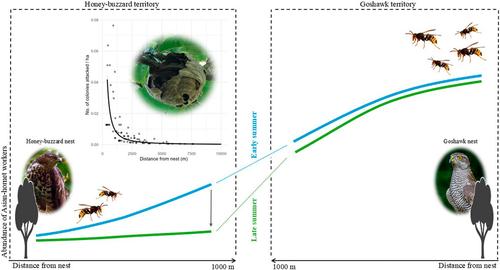当前位置:
X-MOL 学术
›
Pest Manag. Sci.
›
论文详情
Our official English website, www.x-mol.net, welcomes your
feedback! (Note: you will need to create a separate account there.)
The European honey buzzard (Pernis apivorus) as an ally for the control of the invasive yellow‐legged hornet (Vespa velutina nigrithorax)
Pest Management Science ( IF 3.8 ) Pub Date : 2025-01-11 , DOI: 10.1002/ps.8622
Jorge Ángel Martín‐Ávila, Luisa María Díaz‐Aranda, José Manuel Fernández‐Pereira, Salvador Rebollo
Pest Management Science ( IF 3.8 ) Pub Date : 2025-01-11 , DOI: 10.1002/ps.8622
Jorge Ángel Martín‐Ávila, Luisa María Díaz‐Aranda, José Manuel Fernández‐Pereira, Salvador Rebollo

|
BACKGROUNDBiological control in integrated pest management (IPM) often overlooked avian predators until the emergence of the ecosystem services approach. Birds are now recognized as key regulators of pest populations in agroforestry landscapes due to their high mobility. The invasive yellow‐legged hornet, introduced into Europe in 2004, threatens agriculture, beekeeping and native pollinators. We aimed to determine whether European honey buzzard attacks on yellow‐legged hornet nests reduce the densities of individuals (workers) in summer and full‐grown colonies in November around the raptor's nests in southwestern Europe.RESULTSWe analyzed honey‐buzzard foraging patterns of 11 individuals during breeding using trail cameras and GPS emitters to locate attacked hornet nests. The average mode distance from raptor nests to the attacked hornet nests was 1234.7 m, with 89.3% of attacked nests destroyed. We assessed the change in the abundance of hornet workers and in the density of full‐grown nests over distance in the vicinity of 17 honey‐buzzard nests and 10 control points, finding a significant decline of −0.000116 workers h−1 m−1 within 1000 m of a raptor nest. This impact intensified as the breeding season progressed. However, no significant effect on the density of full‐grown hornet nests was observed.CONCLUSIONThese results are of interest for the management of the exotic hornet, at least on the abundance of workers and at a small scale in the proximity of honey‐buzzard nests. These raptors should be considered allies in the fight against hornet populations and included in IPM programmes as a native controller of the pest. © 2025 The Author(s). Pest Management Science published by John Wiley & Sons Ltd on behalf of Society of Chemical Industry.
中文翻译:

欧洲蜜蜂鹰 (Pernis apivorus) 作为控制入侵性黄腿大黄蜂 (Vespa velutina nigrithorax) 的盟友
背景 在生态系统服务方法出现之前,有害生物综合治理 (IPM) 中的生物学控制经常被忽视鸟类捕食者。由于鸟类的高流动性,它们现在被认为是农林业景观中害虫种群的主要调节器。入侵性黄腿大黄蜂于 2004 年引入欧洲,威胁着农业、养蜂业和本地传粉媒介。我们旨在确定欧洲蜜蜂对黄腿大黄蜂巢穴的攻击是否会降低夏季(工蜂)的密度,并在 11 月在欧洲西南部猛禽巢穴周围成熟蜂群的密度。猛禽巢穴到被攻击马蜂窝的平均模式距离为 1234.7 m,89.3% 的被攻击巢被摧毁。我们评估了 17 个蜜蜂鹰巢穴和 10 个控制点附近的大黄蜂工蜂数量和成熟巢穴密度随距离的变化,发现在猛禽巢穴 1000 m 内,工蜂 h-1 m-1 显著下降了 -0.000116 只工蜂 h-1 m-1。随着繁殖季节的进行,这种影响加剧了。然而,未观察到对成年马蜂窝的密度有显著影响。结论这些结果对外来大黄蜂的管理很有意义,至少在工蜂的丰富性和蜜蜂鹰巢附近的小规模管理方面是如此。这些猛禽应被视为对抗大黄蜂种群的盟友,并作为害虫的本地控制者被纳入 IPM 计划。© 2025 作者。由John Wiley & Sons Ltd代表化学工业协会出版的《害虫管理科学》。
更新日期:2025-01-11
中文翻译:

欧洲蜜蜂鹰 (Pernis apivorus) 作为控制入侵性黄腿大黄蜂 (Vespa velutina nigrithorax) 的盟友
背景 在生态系统服务方法出现之前,有害生物综合治理 (IPM) 中的生物学控制经常被忽视鸟类捕食者。由于鸟类的高流动性,它们现在被认为是农林业景观中害虫种群的主要调节器。入侵性黄腿大黄蜂于 2004 年引入欧洲,威胁着农业、养蜂业和本地传粉媒介。我们旨在确定欧洲蜜蜂对黄腿大黄蜂巢穴的攻击是否会降低夏季(工蜂)的密度,并在 11 月在欧洲西南部猛禽巢穴周围成熟蜂群的密度。猛禽巢穴到被攻击马蜂窝的平均模式距离为 1234.7 m,89.3% 的被攻击巢被摧毁。我们评估了 17 个蜜蜂鹰巢穴和 10 个控制点附近的大黄蜂工蜂数量和成熟巢穴密度随距离的变化,发现在猛禽巢穴 1000 m 内,工蜂 h-1 m-1 显著下降了 -0.000116 只工蜂 h-1 m-1。随着繁殖季节的进行,这种影响加剧了。然而,未观察到对成年马蜂窝的密度有显著影响。结论这些结果对外来大黄蜂的管理很有意义,至少在工蜂的丰富性和蜜蜂鹰巢附近的小规模管理方面是如此。这些猛禽应被视为对抗大黄蜂种群的盟友,并作为害虫的本地控制者被纳入 IPM 计划。© 2025 作者。由John Wiley & Sons Ltd代表化学工业协会出版的《害虫管理科学》。































 京公网安备 11010802027423号
京公网安备 11010802027423号